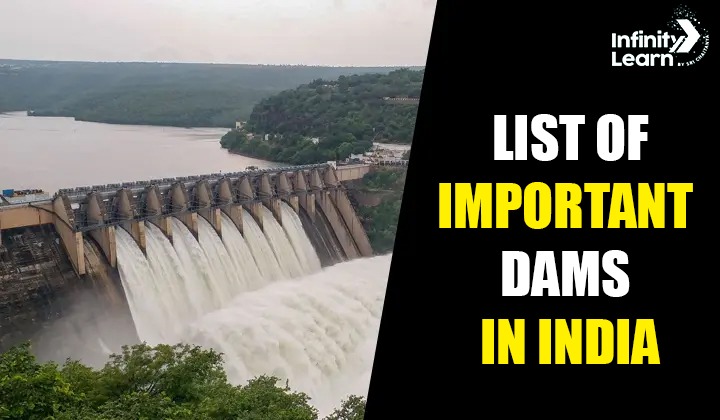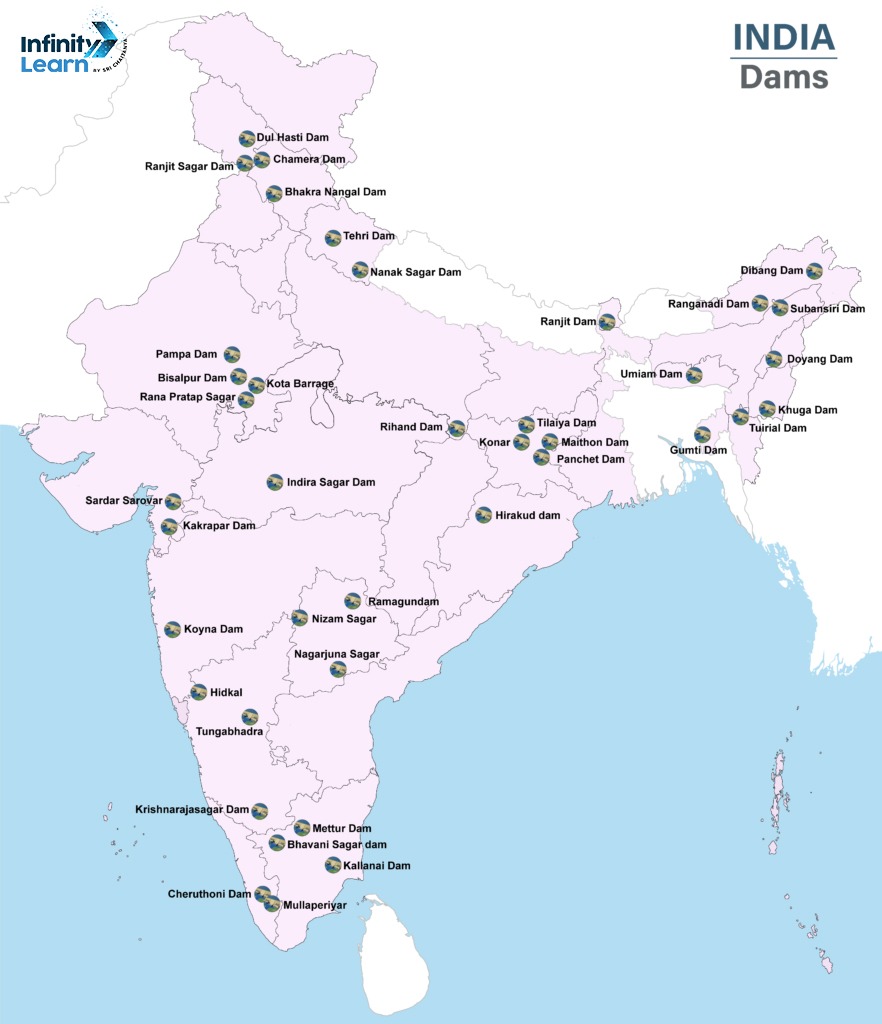Table of Contents
Dams in India: India is home to some of the most significant dams in the world, which are vital for irrigation, electricity generation, and flood control. The highest dam in India, Tehri Dam, stands tall on the Bhagirathi River, while the largest dam in India, Bhakra Nangal, plays a major role in managing water resources. The longest dam in India, Hirakud, stretches across the Mahanadi River, showcasing India’s engineering strength. Understanding the key rivers and dams in India is important for knowing how the country manages its water supply and generates power.

Rivers and Dams in India
India’s vast network of rivers is home to numerous dams, which are essential for controlling floods, providing water for irrigation, and generating hydroelectric power. Major dams like the Bhakra Nangal Dam on the Sutlej River, the Hirakud Dam on the Mahanadi River, and the Tehri Dam on the Bhagirathi River highlight the country’s focus on efficient water management. These rivers and dams in India are not just engineering marvels but are also lifelines for millions, supporting agriculture, industry, and everyday life across the nation. Understanding their significance is key to appreciating India’s resource management.
Dams in India Map

List of Major Rivers and Dams in India
| Dam Name | State | River |
|---|---|---|
| Bhakra Nangal Dam | Himachal Pradesh | Sutlej River |
| Tehri Dam | Uttarakhand | Bhagirathi River |
| Sardar Sarovar Dam | Gujarat | Narmada River |
| Hirakud Dam | Odisha | Mahanadi River |
| Nagarjuna Sagar Dam | Telangana | Krishna River |
| Indira Sagar Dam | Madhya Pradesh | Narmada River |
| Koyna Dam | Maharashtra | Koyna River |
| Rihand Dam | Uttar Pradesh | Rihand River |
| Krishna Raja Sagar Dam | Karnataka | Cauvery River |
| Mettur Dam | Tamil Nadu | Cauvery River |
| Tungabhadra Dam | Karnataka | Tungabhadra River |
| Idukki Dam | Kerala | Periyar River |
| Bhavanisagar Dam | Tamil Nadu | Bhavani River |
Also Check: First Rubber Dam in India
List of Other Important Dams in India with River and State
| Dam Name | State | River |
|---|---|---|
| Nizam Sagar Dam | Telangana | Manjira River |
| Somasila Dam | Andhra Pradesh | Pennar River |
| Srisailam Dam | Andhra Pradesh | Krishna River |
| Singur Dam | Telangana | Manjira River |
| Ukai Dam | Gujarat | Tapti River |
| Dharoi Dam | Gujarat | Sabarmati River |
| Kadana Dam | Gujarat | Mahi River |
| Dantiwada Dam | Gujarat | Banas River |
| Pandoh Dam | Himachal Pradesh | Beas River |
| Bhakra Nangal Dam | Himachal Pradesh and Punjab Border | Sutlej River |
| Nathpa Jhakri Dam | Himachal Pradesh | Satluj River |
| Chamera Dam | Himachal Pradesh | Ravi River |
| Baglihar Dam | Jammu and Kashmir | Chenab River |
| Dumkhar Hydroelectric Dam | J and K | Indus River |
| Uri Hydroelectric Dam | Jammu and Kashmir | Jhelum River |
| Maithon Dam | Jharkhand | Barakar River |
| Chandil Dam | Jharkhand | Swarnarekha River |
| Panchet Dam | Jharkhand | Damodar River |
| Tunga Bhadra Dam | Karnataka | Tungabhadra River |
| Linganamakki Dam | Karnataka | Sharavathi River |
| Kadra Dam | Karnataka | Kalinadi River |
| Alamatti Dam | Karnataka | Krishna River |
| Supa Dam | Karnataka | Kalinadi or Kali River |
| Krishna Raja Sagara Dam | Karnataka | Kaveri River |
| Harangi Dam | Karnataka | Harangi River |
| Narayanpur Dam | Karnataka | Krishna River |
| Kodasalli Dam | Karnataka | Kali River |
| Malampuzha Dam | Kerala | Malampuzha River |
| Peechi Dam | Kerala | Manali River |
| Kundala Dam | Kerala | Kundala Lake |
| Parambikulam Dam | Kerala | Parambikulam River |
| Walayar Dam | Kerala | Walayar River |
| Mullaperiyar Dam | Kerala | Periyar River |
| Neyyar Dam | Kerala | Neyyar River |
| Rajghat Dam | UP and MP Border | Betwa River |
| Barna Dam | Madhya Pradesh | Barna River |
| Bargi Dam | Madhya Pradesh | Narmada River |
| Bansagar Dam | Madhya Pradesh | Sone River |
| Gandhi Sagar Dam | Madhya Pradesh | Chambal River |
| Yeldari Dam | Maharashtra | Purna River |
| Ujani Dam | Maharashtra | Bhima River |
| Pawna Dam | Maharashtra | Maval River |
| Mulshi Dam | Maharashtra | Mula River |
| Koyna Dam | Maharashtra | Koyna River |
| Jayakwadi Dam | Maharashtra | Godavari River |
| Bhatsa Dam | Maharashtra | Bhatsa River |
| Wilson Dam | Maharashtra | Pravara River |
| Tansa Dam | Maharashtra | Tansa River |
| Panshet Dam | Maharashtra | Ambi River |
| Mula Dam | Maharashtra | Mula River |
| Kolkewadi Dam | Maharashtra | Vashishti River |
| Karanja Dam | Maharashtra | Karanja River |
| Totladoh Dam | Maharashtra | Pench River |
| Siruvani Dam | Tamil Nadu | Siruvani River |
| Bhavanisagar Dam | Tamil Nadu | Bhavani River |
How Many Dams in India
India is home to more than 5,000 large dams, which are vital for the nation’s development. These structures are primarily used for irrigation, flood control, and hydroelectric power generation. States like Maharashtra and Gujarat have the highest concentration of dams, serving millions of farmers and households. Dams also play a significant role in managing water resources, especially in regions facing droughts. While they support agriculture and provide electricity, it’s essential to address the environmental and social impacts associated with dam construction.
Also Check: Biggest Dam in Maharashtra
Highest Dam in India
The Tehri Dam, located in Uttarakhand, is the highest dam in India, standing at 260.5 meters (855 feet). Built on the Bhagirathi River, this multi-purpose dam serves several functions, including hydroelectric power generation, irrigation, and drinking water supply. With a power generation capacity of 1,000 MW, it significantly contributes to the country’s renewable energy resources. The Tehri Dam not only benefits the surrounding communities by providing water and electricity but also plays a crucial role in flood management in the region.
Also Check: Highest Dam in India
Largest Dam in India
The Bhakra Nangal Dam, situated on the Sutlej River in Himachal Pradesh, is the largest dam in India in terms of reservoir capacity. It spans 225.5 meters (740 feet) in height and creates the Bhakra Reservoir, which can hold around 9.34 billion cubic meters of water. This dam is essential for irrigation, supporting agriculture in northern India, and generating hydroelectric power with a capacity of 1,325 MW. Additionally, it plays a significant role in controlling floods, ensuring a stable water supply, and boosting the economy.
Longest Dam in India
The Hirakud Dam, located on the Mahanadi River in Odisha, holds the title of the longest dam in India. Stretching over 25.8 kilometers (16 miles), it was completed in 1957 and serves multiple purposes. The dam plays a critical role in irrigation, flood control, and hydroelectric power generation, with a capacity of 347.5 MW. Its massive reservoir provides water to thousands of acres of farmland, helping farmers improve their yields. Hirakud Dam is not only a vital infrastructure project but also a symbol of development in the region.
Biggest Dam in India
The Bhakra Nangal Dam is often referred to as the biggest dam in India due to its immense storage capacity and significant impact on water management. Spanning the Sutlej River, it stands at a height of 225.5 meters (740 feet) and creates one of the largest reservoirs in the country. This dam is crucial for irrigation, supporting millions of farmers across northern India, and generating substantial hydroelectric power. Its construction has transformed the agricultural landscape and helped stabilize water resources, showcasing the importance of large dams in India’s development.
Importance of Dams in India
Dams in India play a crucial role in the country’s development and sustainability. The following points highlight their importance:
- Water Supply: Dams provide a reliable source of water for irrigation, helping farmers grow crops, especially in arid regions.
- Hydroelectric Power Generation: Many dams, such as the Bhakra Nangal Dam, are vital for generating renewable energy, contributing to India’s power needs.
- Flood Control: Dams help manage water flow during heavy rains, reducing the risk of floods and protecting communities downstream.
- Recreation and Tourism: Dams create reservoirs that offer opportunities for recreational activities like boating, fishing, and tourism, boosting local economies.
- Soil Conservation: By controlling water flow, dams prevent soil erosion and help maintain soil fertility in surrounding areas.
Facts About Dams in India
Dams in India are fascinating structures with significant historical and cultural relevance. Here are some interesting facts:
- Largest Dam in India: The Bhakra Nangal Dam is the largest dam in India in terms of storage capacity, playing a vital role in irrigation and hydroelectric power.
- Longest Dam in India: The Hirakud Dam is recognized as the longest dam in India, stretching over 25.8 kilometers (16 miles) and providing essential water management functions.
- Biggest Dam in India: The Bhakra Nangal Dam is also often referred to as the biggest dam due to its massive capacity and impact on agriculture and energy generation.
- Number of Dams: India has over 5,000 large dams, each serving various purposes, including irrigation, water supply, and flood control.
- Environmental Impact: While dams offer many benefits, it’s important to consider their environmental impact, including changes to local ecosystems and communities.
Dams in India FAQs
What are the primary purposes of dams in India?
In India, dams have a variety of uses, such as irrigation, the production of hydroelectric power, flood control, the provision of water for home and industrial usage, and leisure activities.
Which is the largest dam in India by storage capacity?
The Bhakra Nangal Dam, located in Himachal Pradesh and Punjab, is the largest dam in India by storage capacity, significantly contributing to irrigation and power generation.
What challenges are associated with dam construction in India?
Challenges include displacement of local communities, environmental impact, sedimentation, and maintaining the structural integrity of dams amid climate change and extreme weather events.
Which dam is known as the Lifeline of Maharashtra?
The Koyna Dam is often referred to as the Lifeline of Maharashtra due to its significant role in hydroelectric power generation and irrigation in the state.
Which is the Biggest Dam in India?
The biggest dam in India, in terms of volume of concrete used, is the Bhakra Nangal Dam. Located on the Sutlej River in Himachal Pradesh and Punjab, it stands as a critical infrastructure project for irrigation, power generation, and flood control. Completed in 1963, the dam has a height of 226 meters and a reservoir capacity of approximately 9.34 billion cubic meters, making it an essential lifeline for agriculture in northern India.
Which State Has More Dams?
Maharashtra holds the title for the state with the most dams in India. The state is home to over 3,000 dams, including significant ones like the Koyna Dam and the Bhatsa Dam. These dams are essential for irrigation, power generation, and managing water resources, playing a critical role in supporting Maharashtra's agricultural economy and meeting the water needs of its growing population.









